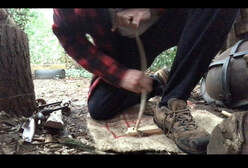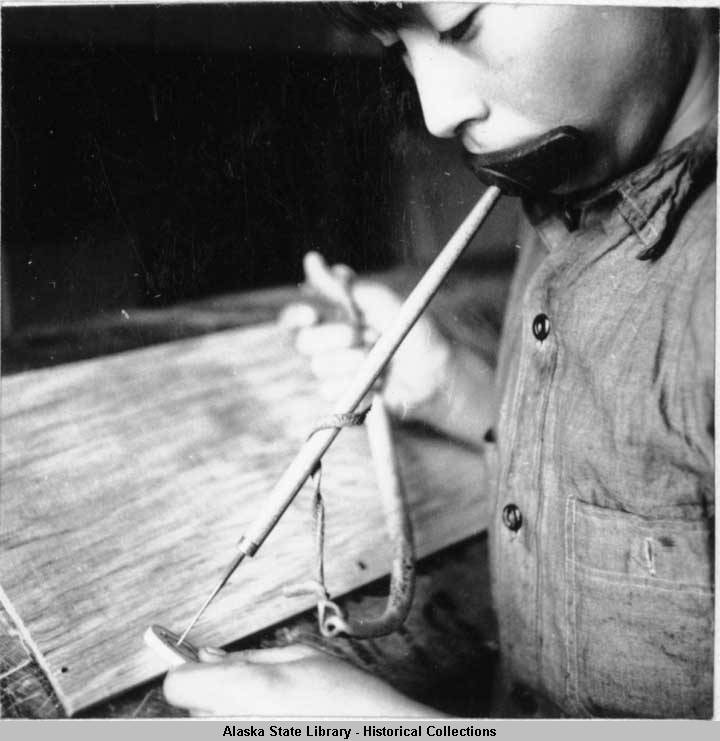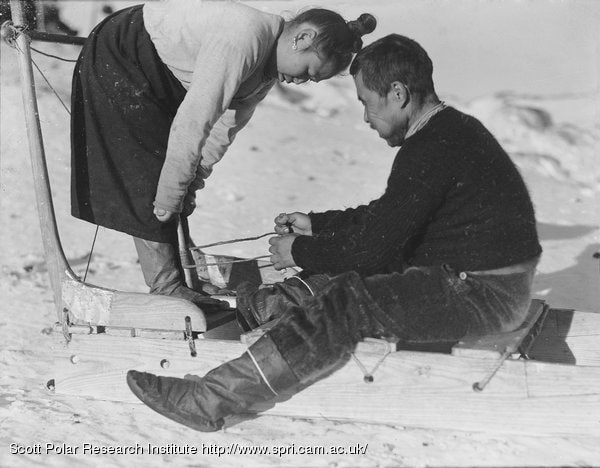 Today I was playing with the #firebrace to experiment with uni-directional friction fire - to see a clip on IG click here Checkout #crookedstickfrictionfire on IG to see @wur_thaz_smoke nail it! (Photo 1 below) All kudos to Rich as it's not easy! @phyredojo also posted an excerpt from Charles Darwin yesterday (photo 2) where apparently according to Darwin the Gaucho’s deployed a method similar to the fire brace (as I am terming it!) - all credit to phyredojo for finding and posting that fascinating #fireancestry snippet (I must read that book.) The advantage with one-directional is that the spindle rotates continuously without stopping - the disadvantage - how do you get the speed!? It is easier to spin spindles fast with cord or hands but not so without! You need to apply a lot more pressure to make up for lack of speed. I’ve tried before and my experiments today failed which I knew they would. My first stick was too thin and snapped as you need to apply a lot more pressure. The 2nd one using my dad’s old woodworking brace failed as I couldn’t go fast enough - the handle too wide so taking too long to turn. Like I say checkout Rich’s #crookedstickfrictionfire as he nailed it - a good sturdy crooked stick with the correct crookedness 😀 and applying enough pressure by putting bearing under his armpit. As I discovered it’s actually not as easy to find the right crooked stick when you want a crooked stick! This is another one on my to do list 😀 Sir James Fraser (19th c anthropologist) mentions another uni-directional method by using a cart wheel for neid fire - the spindle goes thru middle - it is stood upright and spun via the wheel by a few good strong people apparently. You’d probably need a fire churn apparatus but instead of the rope you use the wheel to turn the spindle. This is another on my to do list 😀
Following my successful attempt yesterday, to coax an ember using the "Inuit" mouth drill strap drill method I have been asking myself "did the Inuit’s actually use the mouth drill for fire making ?" Yes using the mouth drill to coax an ember is possible , it isn't very pleasant though as you have smoke in your face which you can easily breathe, and it's not comfortable applying the pressure, you could damage your teeth and I nearly burnt my lips !
All of the pics I have seen have been Inuits using the mouth drill for decorating ivory. I can see the reason for using a mouth hold to decorate ivory as it frees up a hand to manipulate the ivory so to carve designs. I have seen a few similar pictures of mouth drill fire sets in museums but I’ve not seen a picture of Inuits actually using mouth drill to make fire. So it intrigued me – was this technique actually used to make fire… did they use traditional bearing block for making fire (I have seen a picture of 2 Inuit's using the strap drill - see below) or because they were so skilled at using mouth hold did they also use for fire making? Or have us westerners assumed that; and are the sets in museums assumed replicas ?😀 I may do more digging – I do find the Inuits fascinating. Anyway the mouth drill does work for fire making if you wish to use it 😀 1 - Eskimo school boy drilling ivory with primitive bow drill. Little Diomede Island, 3/1942. https://vilda.alaska.edu/digital/collection/cdmg21/id/952 Pic 2- Man using a bow drill. King Island, circa 1920 by Edward S. Curtis, courtesy of the Library of Congress, 3a16199. https://alaska.si.edu/media.asp?id=643&object_id=670 3 and 4 – Inuit bow drill set. Penn museum https://www.penn.museum/blog/museum/arctic-bow-drill/ 5 Three sides of a ivory drill bow, 1880s. Lowie Museum https://edblogs.columbia.edu 6 - icodemus, an Inuit man sits on a wooden sledge. He holds the two ends of a piece of string which is wound round a pole. Gusdiana, an Inuit woman, bends over and holds the top of the pole at knee height to steady it. 1930 https://www.freezeframe.ac.uk/collection/photos-british-arctic-air-route-expedition-1930-31/p48-16-79 7 –a Inuit fire drill thong with mouth hold – I have seen a few of these but no one actually using one to make fire . Science museum. I can now say I have successfully used the mouth drill ! But I won't be doing it again!
The mouth drill is of Inuit ancestry, where the mouth holds the bearing block and you apply the downward pressure with your head basically! I used it as a strap drill and used a thinner spindle. I needed lots of wraps of the cordage around the spindle to get the tension. It did work very well but it wasn't very pleasant! I’ve seen photos of Inuits using a bow drill and they hold the set on their lap whilst sitting (that has been more for drilling than fire making.) I carved a bearing block so I could hold it in my mouth but I have also seen Inuit bearing blocks which fit onto the chin rather than the mouth. I think the mouth drill was used more for drilling (not fire making) - and they would use a bow so it would free up a had to do other things! There are records of friction fire in many ancient texts, one of the oldest translated texts mentioning friction fire may be the Theology of the Phoenicians (photo obviously of a modern reprint😀)
From Wikipedia: Phoenicia was an ancient Semitic-speaking thalassocratic civilization founded 2500BC that originated in the Levant region of the eastern Mediterranean, primarily modern Lebanon. It was concentrated along the coast of Lebanon and included some coastal areas of modern Syria and Galilee, reaching as far north as Arwad and as far south as Acre and possibly Gaza. At its height between 1100 and 200 BC, Phoenician civilization spread across the Mediterranean, from the Levant to the Iberian Peninsula. THEOLOGY OF THE PHŒNICIANS FROM SANCHONIATHO is one of 3 lost works originally written in the Phoenician language and surviving only in partial paraphrase and summary of a Greek translation by Philo of Byblos, according to the Christian bishop Eusebius. These few fragments comprise the most extended literary source concerning Phoenician religion in either Greek or Latin: Phoenician sources, along with all of Phoenician literature, were lost with the parchment on which they were written.” Quoted from Theology of the Phoenicians (sacred-texts.com): “ Afterwards by Genus the son of Æon and Protogonus were begotten mortal children, whose names were Phôs, Pûr, and Phlox. These found out the method of producing fire by rubbing pieces of wood against each other, and taught men the use thereof.” I came across this a round about way via Pliny (79Ad) - see the blog post on Pliny Fire origin stories are common across most cultures , and friction fire rather than percussion is the one most mentioned. So far I've not found much on friction fire in Japan apart from the below picture in Walter Hough's Fire Making Apparatus book. It doesn't say much about it, other than it was used by the priest. I need to try and do a bit more digging when I have time.
placeholder\reminder - I hope to write a proper article at some point!
The fire plane - just come across this - another variation of friction method - not sure how it would work. i may experiment and post about it. https://www.jstor.org/stable/3773466?read-now=1&refreqid=excelsior%3A8bb26e60bc45e6ebff469bdc456c6eb0&seq=4#page_scan_tab_contents host spindles and socketed hand drills lost of evidence that host and socketed hand drill spindles used all throughout world - see Walter Hough - Fire Making Apparatus in the United States National Museum for some examples I may write a separate article one day |
Archives
January 2024
Categories
All
|














 RSS Feed
RSS Feed